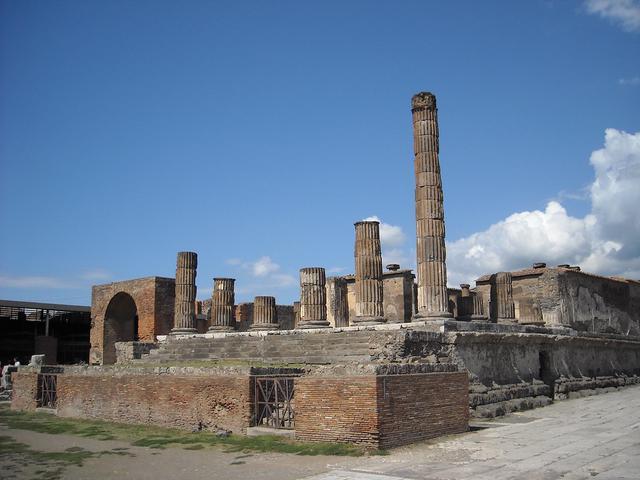Temple of Jupiter or Capitol

The Temple of Jupiter, also known as the Capitol, is a magnificent structure that stands as a testament to the rich history and architectural prowess of ancient Pompeii. Situated in the heart of the Forum, this temple commands attention with its imposing presence and intricate design. The temple is a prime example of Etruscan-Italic architectural tradition infused with Hellenistic influences, showcasing a harmonious blend of styles that were prevalent during that era.
As visitors approach the Temple of Jupiter, they are greeted by a grand staircase made of tufa stone, leading up to a spacious pronaos adorned with six Corinthian-Italic columns at the front. The interior of the temple features a cell divided by two rows of Ionic columns, culminating in a tripartite pedestal believed to have held statues of worship. The walls of the cell are adorned with second style paintings, while the exterior boasts a marble stucco coating that adds to its grandeur.
The discovery of the Temple of Jupiter in 1816 was a momentous occasion that shed light on the religious and architectural practices of ancient Pompeii. Scholars have meticulously studied the temple to determine its origins and significance, with questions arising about whether it was Roman or pre-Roman in construction. The temple's design and layout have provided valuable insights into the cultural and religious beliefs of the people who once worshipped within its walls.
Despite the passage of time and the ravages of nature, the Temple of Jupiter continues to stand as a symbol of Pompeii's rich heritage and artistic achievements. Visitors can marvel at the intricate details of the temple's architecture, from the finely carved columns to the elaborate decorations that adorn its walls. The temple's significance extends beyond its physical structure, serving as a window into the past and a reminder of the enduring legacy of the ancient city of Pompeii.
In conclusion, the Temple of Jupiter is a must-see attraction for anyone visiting Pompeii, offering a glimpse into the religious and architectural practices of a bygone era. Its historical significance, combined with its stunning design, make it a focal point of the city's cultural heritage. As visitors explore the temple grounds and marvel at its beauty, they are transported back in time to a period of great artistic and spiritual flourishing. The Temple of Jupiter stands as a testament to the ingenuity and creativity of the ancient Pompeiians, leaving a lasting impression on all who have the privilege of experiencing its grandeur.
© ChatGPT 3.5